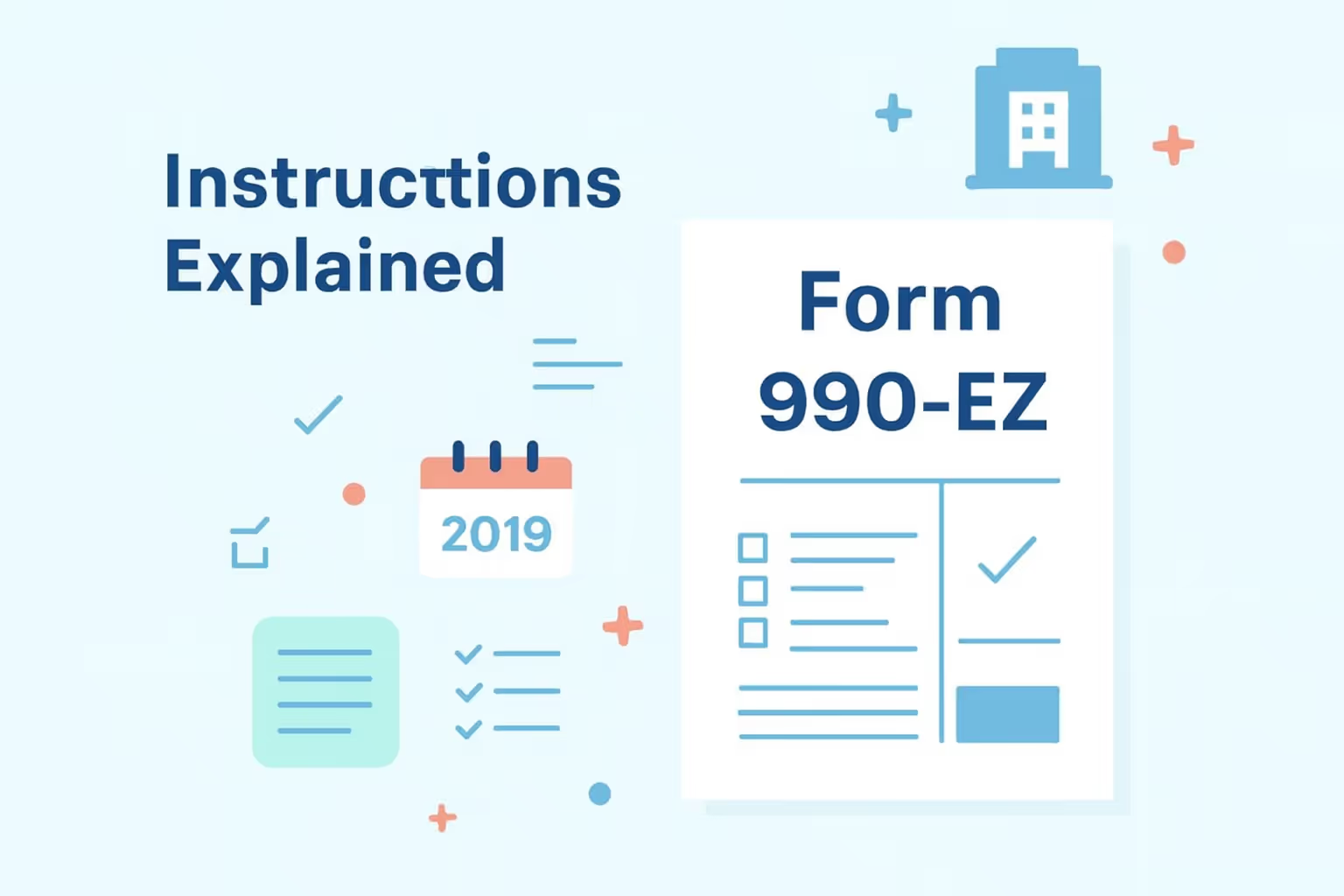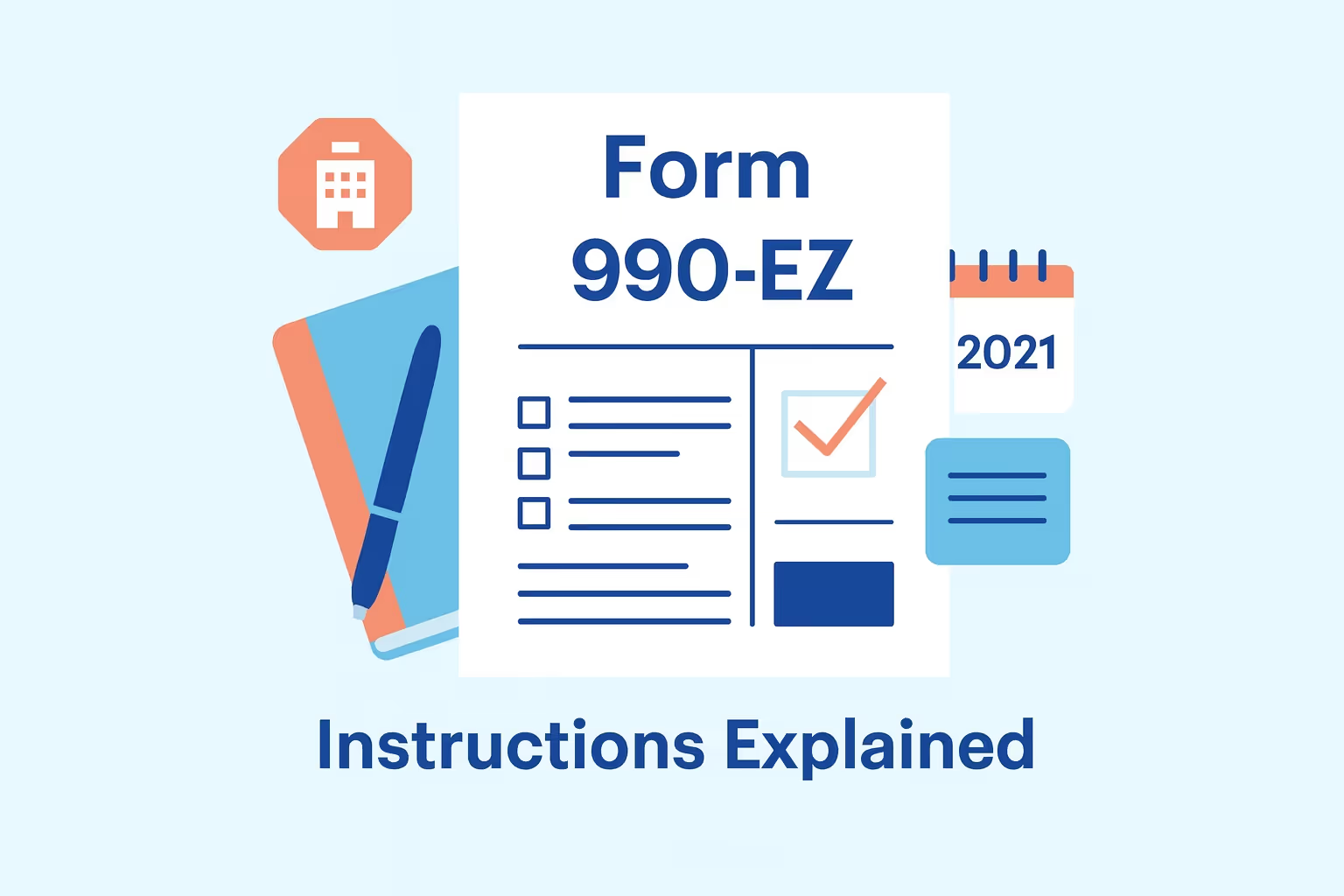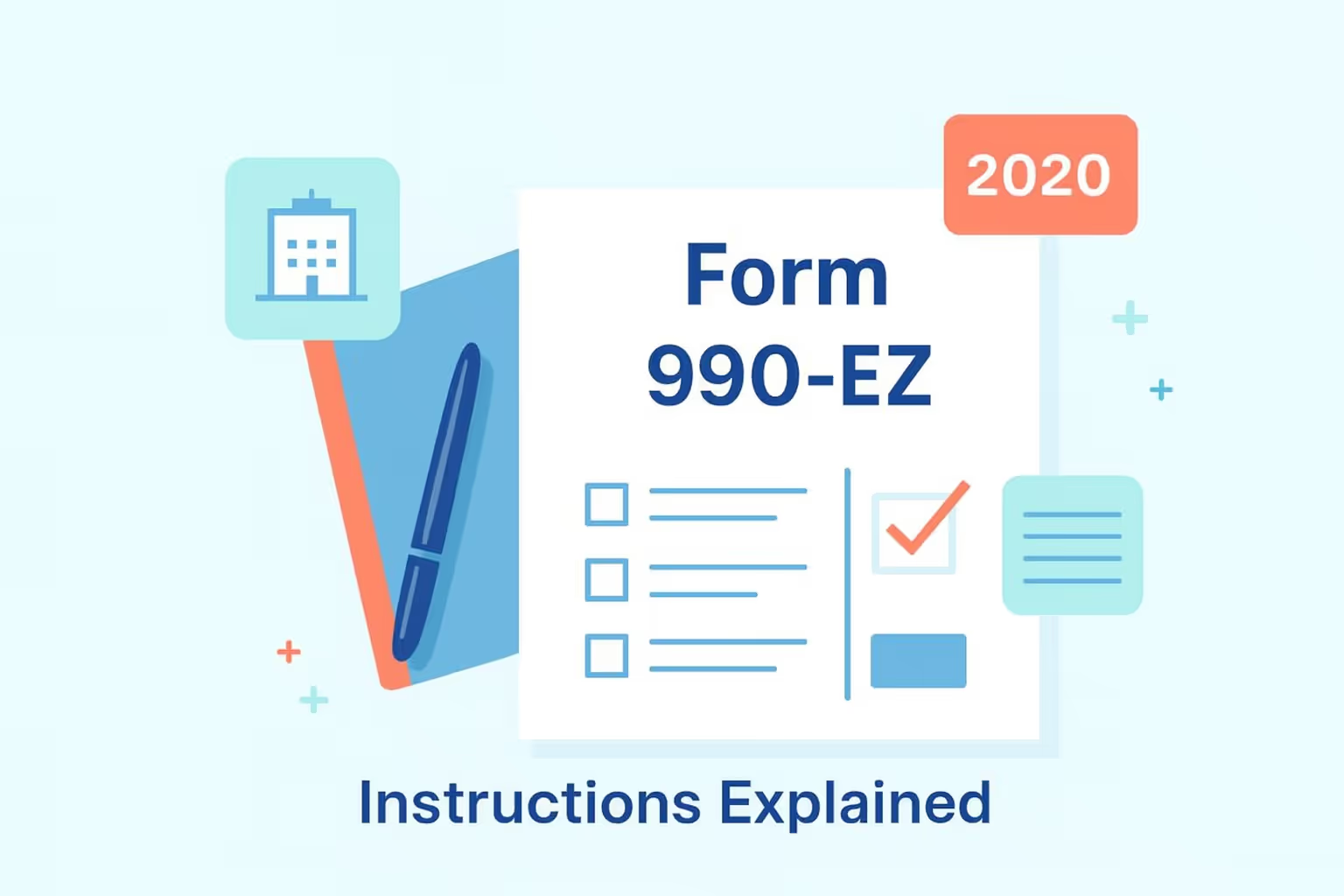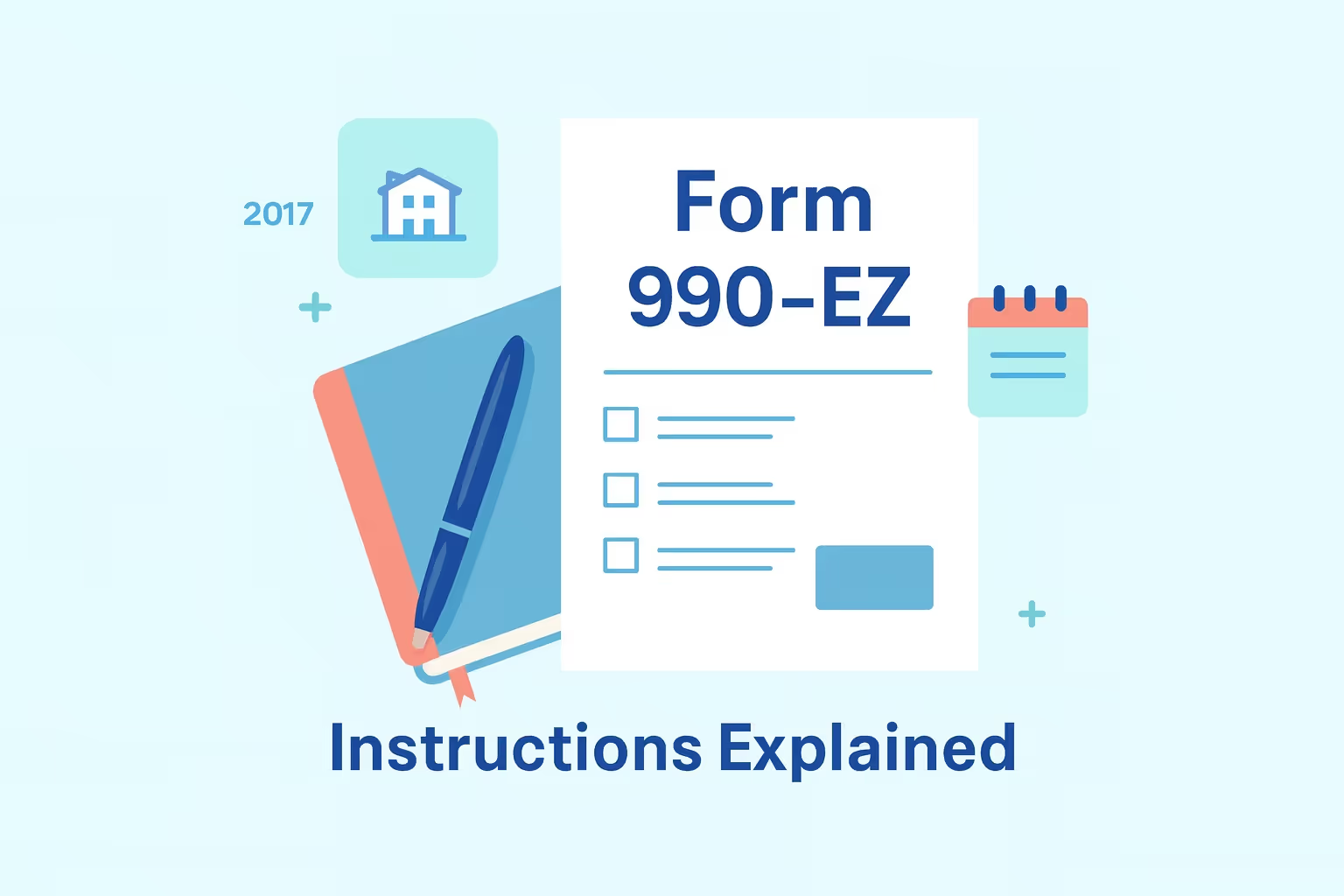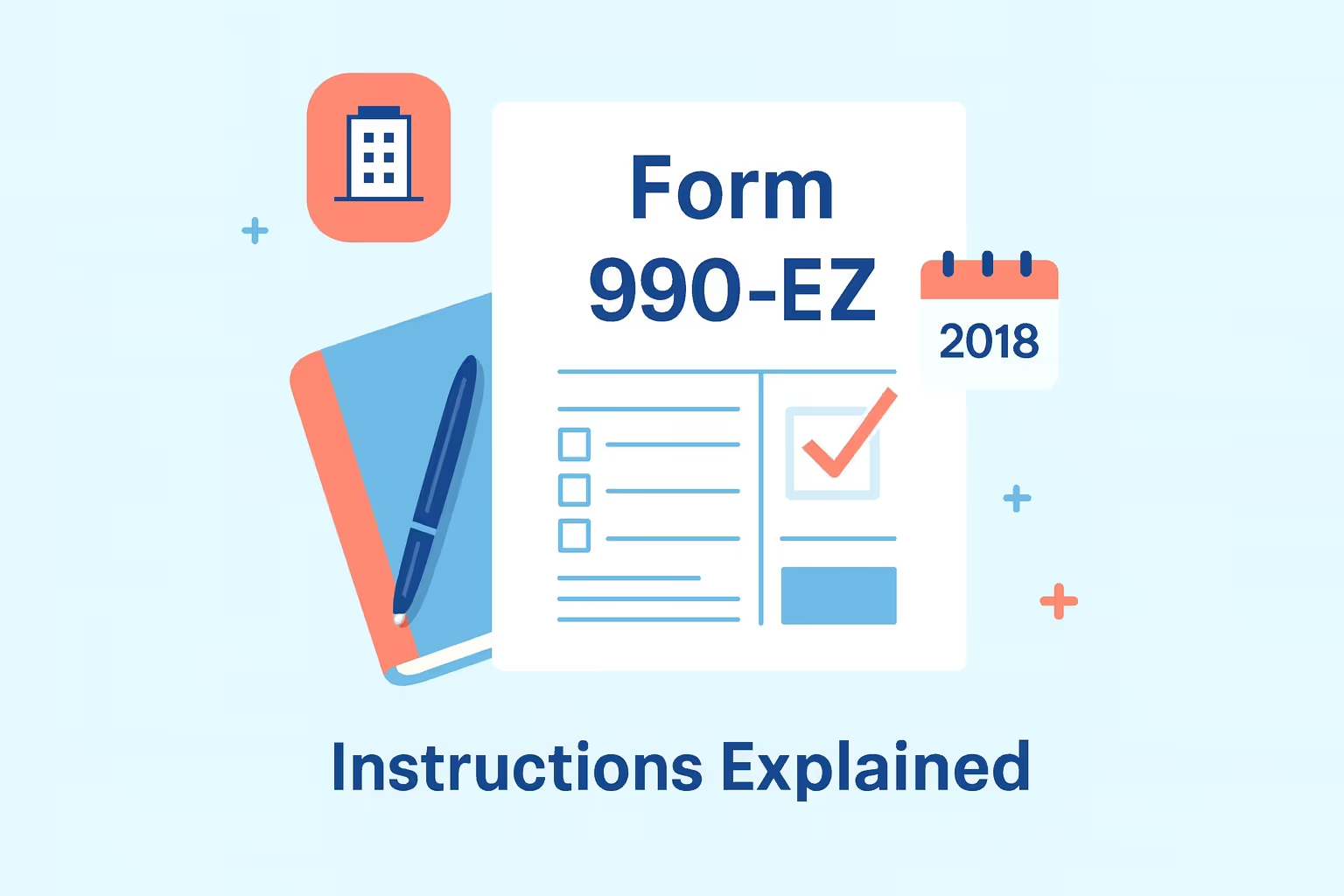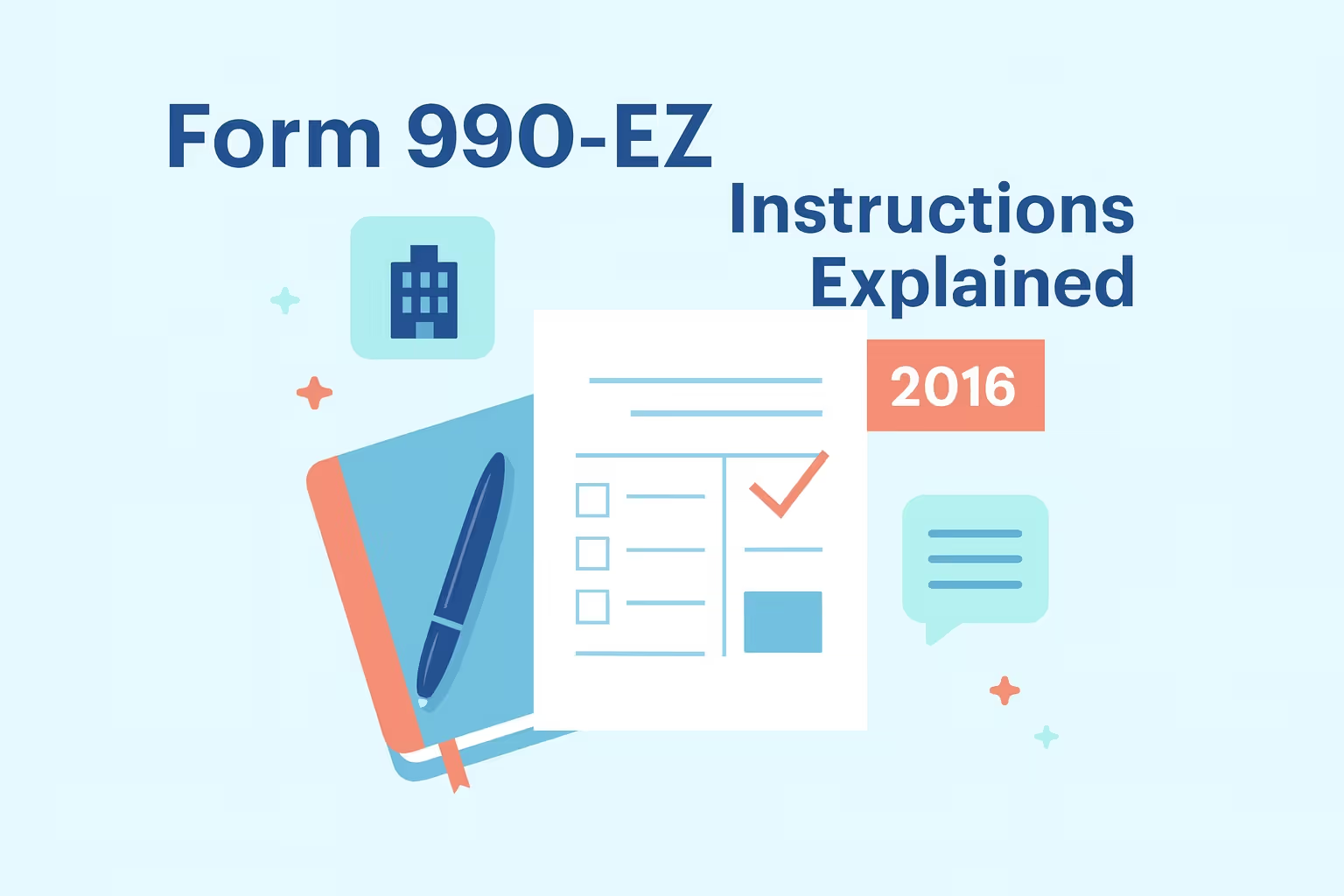Instrucciones para el formulario 990-EZ 2015: Guía de presentación para organizaciones sin fines de lucro
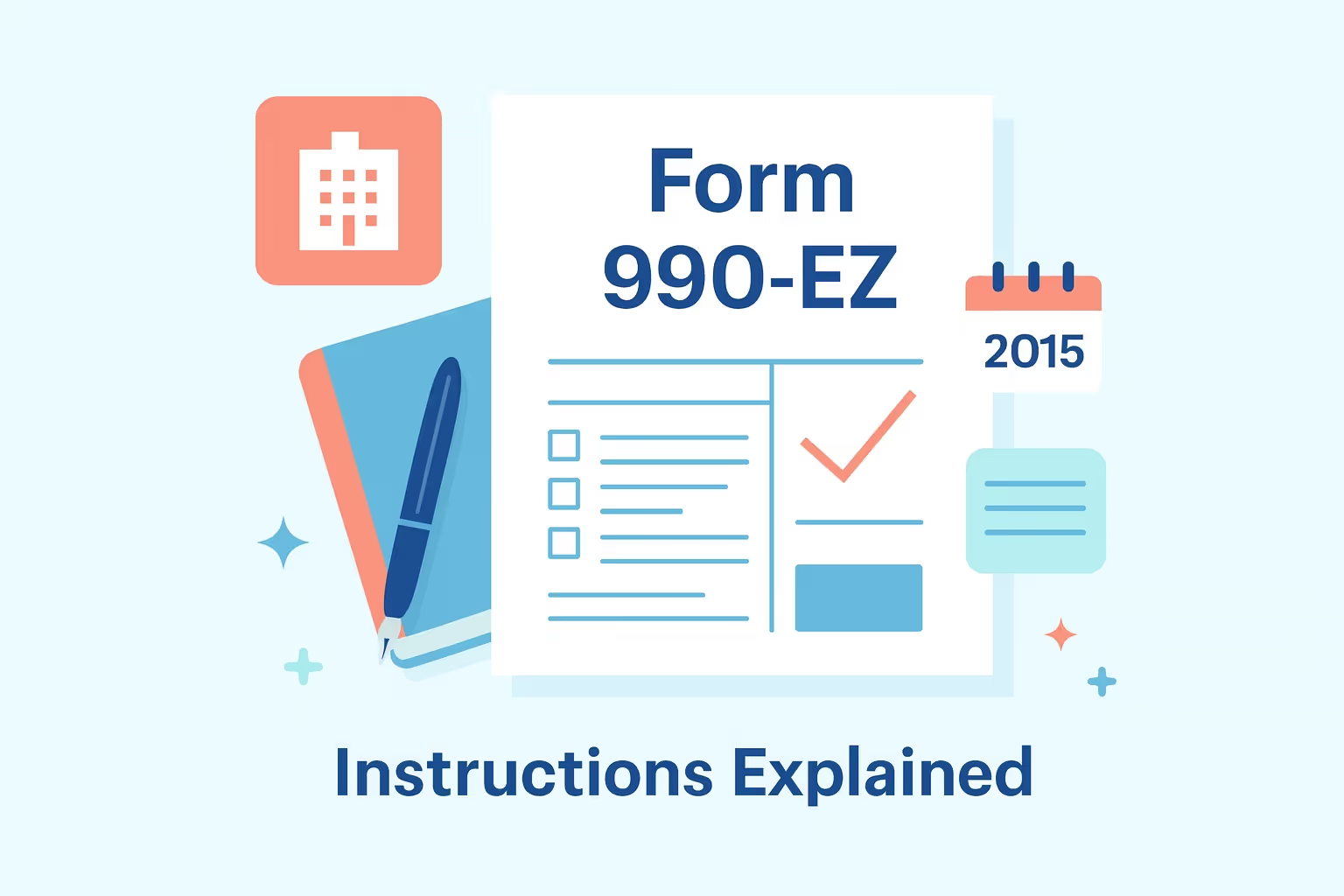
La presentación del formulario 990-EZ para el año tributario 2015 es un requisito esencial para las organizaciones sin fines de lucro que se encuentran dentro de los límites específicos de ingresos y activos. Esta declaración informativa garantiza que las organizaciones exentas de impuestos se mantengan al día con el Servicio de Impuestos Internos y, al mismo tiempo, brinda a los donantes y al público confianza en la forma en que se administran los fondos. Dado que está diseñado para grupos más pequeños, el formulario 990-EZ ofrece una alternativa simplificada al formulario 990 completo, a la vez que exige la presentación de informes precisos sobre los ingresos, los gastos y las actividades. Refleja con precisión los ingresos, los costos y los logros del programa.
Para muchas organizaciones exentas en virtud de la sección 501 (c), la presentación de la solicitud puede resultar abrumadora, especialmente cuando surgen dudas sobre la elegibilidad, las extensiones o la información que se requiere. Se espera que los funcionarios de las organizaciones sin fines de lucro revisen y preparen estados detallados de ingresos, activos y estructuras de gobierno. El proceso requiere el acceso a los datos financieros, la atención a los plazos de presentación y la capacidad de presentar la información en un formato claro y conciso. La presentación correcta no solo protege la condición de exento, sino que también demuestra la responsabilidad ante los donantes, las juntas directivas y las comunidades a las que sirven.
Esta guía proporciona instrucciones paso a paso para preparar y enviar el formulario 990-EZ para el año tributario 2015. Explica quién es elegible, qué informes de ingresos y fondos se aplican y cómo los grupos sin fines de lucro pueden cumplir con las normas del IRS. Cada sección está diseñada para simplificar el proceso, reducir los errores de presentación y proporcionar un camino claro a seguir.
Elegibilidad, reglas de presentación y plazos clave
Las organizaciones sin fines de lucro pueden presentar el formulario 990-EZ si cumplen con los umbrales financieros establecidos para el año tributario 2015. El formulario se aplica a las organizaciones exentas de impuestos con ingresos brutos inferiores a 200 000$ y activos totales inferiores a 500 000$ al final del año. Estos límites permiten a las organizaciones sin fines de lucro más pequeñas declarar sus ingresos, gastos y actividades sin tener que preparar el formulario 990, que es más complejo. La presentación correcta protege la condición de exención, garantiza el cumplimiento y demuestra a los donantes que los fondos se administran con responsabilidad.
Es posible que algunas organizaciones necesiten utilizar declaraciones alternativas del IRS, incluso si cumplen con los criterios de ingresos y activos. Las fundaciones privadas y los fideicomisos caritativos no exentos deben presentar formularios separados, incluido el formulario 990-PF o el formulario 990 completo. Las organizaciones sin fines de lucro que administran centros hospitalarios o actúan como grupos de patrocinio de fondos asesorados por donantes tampoco cumplen con los requisitos de elegibilidad para el formulario 990-EZ. Guía publicada en el Sección «Acerca del formulario 990-EZ» de IRS.gov describe claramente estas reglas, lo que permite a las organizaciones determinar qué presentación se aplica.
Elegible para presentar el formulario 990-EZ
- Ingresos brutos: Una organización con ingresos anuales inferiores a 200 000$ reúne los requisitos para utilizar la declaración simplificada.
- Activos totales: Una organización con menos de 500 000$ en activos al final del año cumple con el requisito de presentación.
- Tipo de organización: La mayoría de las organizaciones exentas en virtud de la sección 501 (c) reúnen los requisitos para presentar una solicitud si cumplen con los estándares federales.
- Opción de tarjeta postal electrónica: Los grupos con ingresos anuales de 50 000$ o menos pueden optar por presentar el formulario 990-N, también conocido como tarjeta postal electrónica.
No es elegible para presentar el formulario 990-EZ
- Fundaciones privadas: Se requiere presentar el formulario 990-PF para divulgar las subvenciones, los fondos y las distribuciones.
- Fideicomisos caritativos no exentos: Estos fideicomisos deben presentar formularios de impuestos sobre la renta porque no están exentos de impuestos.
- Instalaciones hospitalarias: Las organizaciones que administran hospitales deben presentar el Formulario 990 completo.
- Patrocinadores de fondos asesorados por donantes: Estos patrocinadores deben completar el formulario 990 para informar sobre los fondos de donantes administrados.
Los plazos de presentación dependen del ejercicio contable. Los declarantes del año calendario deben presentar las declaraciones antes del 15 de mayo de 2016, mientras que los declarantes del año fiscal deben presentarlas antes del decimoquinto día del quinto mes después del cierre del año fiscal. Las organizaciones que no presenten sus solicitudes durante tres años consecutivos perderán automáticamente su condición de exentas de impuestos, incluso si anteriormente se les concedió una prórroga.
El cumplimiento de las normas de elegibilidad y los plazos de presentación ayuda a las organizaciones sin fines de lucro a mantener la credibilidad ante los donantes y los reguladores. También refuerza la confianza del público al demostrar una gestión financiera responsable y una presentación transparente de los ingresos y gastos. Una preparación cuidadosa, la presentación puntual y la elección de la declaración correcta ayudan a proteger el cumplimiento y, al mismo tiempo, a fomentar la confianza a largo plazo en la organización.
Informes de impuestos sobre la renta y sin fines de lucro
El formulario 990-EZ sirve como una declaración informativa en lugar de una presentación estándar de impuestos sobre la renta. Las organizaciones sin fines de lucro lo utilizan para informar sobre la actividad financiera, los detalles de la gobernanza y los logros de los programas, no para calcular ni pagar el impuesto sobre la renta. El IRS, los donantes y el público confían en esta información para confirmar que los fondos se administran de manera responsable y de acuerdo con el propósito exento de la organización.
Si bien el formulario 990-EZ no implica una obligación tributaria, las organizaciones sin fines de lucro con ingresos comerciales no relacionados deben preparar declaraciones de impuestos adicionales en condiciones específicas. Cualquier grupo que gane 1000 dólares o más en ingresos comerciales no relacionados debe presentar el formulario 990-T, que somete esos fondos al impuesto federal sobre la renta. Este requisito garantiza que las organizaciones sin fines de lucro que se dedican a actividades comerciales no relacionadas con su misión contribuyan de manera justa junto con las empresas sujetas a impuestos. La presentación de informes precisos sobre los ingresos exentos y sujetos a impuestos es esencial para mantener el cumplimiento y la credibilidad.
La distinción entre ingresos exentos y sujetos a impuestos define las responsabilidades de cada funcionario sin fines de lucro. Los ingresos exentos incluyen las contribuciones, las subvenciones y los ingresos por servicios del programa que apoyan directamente el propósito caritativo de la organización. Los ingresos imponibles incluyen las ganancias de actividades comerciales no relacionadas, como el alquiler de propiedades o la venta de servicios que no están directamente relacionados con el propósito o la misión principales de la organización. La separación adecuada de estas categorías ayuda a las organizaciones a presentar las declaraciones de impuestos correctas, a mantener la transparencia ante los donantes y a evitar errores que podrían afectar su estado de exención.
Instrucciones paso a paso para completar el formulario 990-EZ
La preparación del formulario 990-EZ para el año tributario 2015 requiere un enfoque estructurado que garantice que cada sección se aborde correctamente. Las organizaciones sin fines de lucro deben recopilar datos precisos, proporcionar declaraciones coherentes y completar cada parte del formulario con cuidado. Seguir un proceso sistemático reduce los errores de presentación, protege la exención y demuestra la responsabilidad ante los donantes y los reguladores.
Paso 1: Reunir la información requerida
Antes de completar la declaración, los funcionarios de la organización sin fines de lucro deben recopilar los registros financieros y los datos organizacionales necesarios para informar con precisión. Los documentos esenciales incluyen los estados de ingresos, los balances y los informes de actividad del programa. La información sobre los funcionarios, directores y fideicomisarios también debe estar disponible para confirmar los detalles de la gobernanza. Tener estos datos organizados mejora la capacidad de preparar la declaración de manera eficiente y precisa.
Paso 2: Complete la sección de encabezado
El encabezado debe identificar con precisión la organización para evitar demoras en el procesamiento. Las organizaciones sin fines de lucro deben proporcionar el nombre legal, la dirección postal y el número de identificación del empleador correctos; el período contable, ya sea un año calendario o un año fiscal, debe indicarse claramente. Los funcionarios deben marcar la casilla para las declaraciones iniciales, finales o modificadas, cuando corresponda.
Paso 3: Informar los ingresos, los gastos y los activos netos
La parte I del formulario 990-EZ cubre la actividad financiera del año. Las organizaciones sin fines de lucro declaran las contribuciones, las subvenciones y los ingresos por servicios de los programas, junto con los gastos relacionados con las operaciones. Otras fuentes de ingresos, como las ganancias por inversiones, deben incluirse por separado. La sección concluye con los cambios en los activos netos o los saldos de los fondos, que proporcionan un panorama financiero de la organización.
Paso 4: Proporcione la información del balance
La parte II examina la situación financiera de la organización al principio y al final del año. Los activos, pasivos y activos netos deben declararse de manera coherente con los registros contables. Las valoraciones precisas demuestran la estabilidad financiera de la organización, lo que permite a los donantes y a las partes interesadas evaluar su administración eficaz de los recursos.
Paso 5: Describa los logros del servicio del programa
La parte III exige una descripción de las actividades relacionadas con la misión. Las organizaciones sin fines de lucro deben resumir sus programas principales y explicar cómo los fondos apoyaron esos objetivos. La presentación transparente de informes sobre los logros permite a los reguladores y a los donantes evaluar la forma en que los fondos respaldan el propósito exento de la organización.
Paso 6: Identificar a los funcionarios y empleados clave
La Parte IV enumera a los funcionarios, directores y empleados clave junto con sus horas y compensación. Las organizaciones sin fines de lucro deben divulgar esta información para demostrar la transparencia en la gobernanza. Los informes deben ser precisos y coherentes con los registros de nómina y personal. La responsabilidad pública fomenta la confianza y mejora la credibilidad de la organización cuando los funcionarios y empleados clave son informados con precisión.
Paso 7: Abordar las preguntas de cumplimiento
La parte V contiene preguntas sobre asuntos de cumplimiento, incluidas las actividades políticas, las cuentas en el extranjero y las prácticas de recaudación de fondos. Los funcionarios de organizaciones sin fines de lucro deben responder cada pregunta con cuidado y proporcionar explicaciones adicionales cuando sea necesario. La presentación de informes honestos garantiza que la organización cumpla con los estándares federales para las organizaciones exentas.
Paso 8: Complete las divulgaciones de la Sección 501 (c) (3)
La Parte VI se aplica solo a las organizaciones reconocidas en virtud de la sección 501 (c) (3) y a ciertos fideicomisos. Estos grupos deben proporcionar información adicional relacionada con sus operaciones y el cumplimiento de las normas caritativas. Preparar estas respuestas con declaraciones de respaldo ayuda a proteger la exención de impuestos y demuestra prácticas de gobierno sólidas.
Paso 9: Adjuntar cronogramas e información complementaria
Muchas organizaciones deben completar y adjuntar cronogramas en función de sus actividades. Los cronogramas proporcionan información detallada sobre los contribuyentes, la recaudación de fondos, el cabildeo y otras áreas especializadas de interés. Es posible que las organizaciones también deban presentar declaraciones complementarias a través del Anexo O, en el que se explican las respuestas que figuran en otras partes del formulario. Adjuntar los cronogramas aplicables garantiza que la declaración esté completa y cumpla con los requisitos.
Completar el formulario 990-EZ de esta manera estructurada proporciona a las organizaciones sin fines de lucro un marco confiable para la presentación de informes precisos. Al preparar los documentos, completar cada sección con cuidado y adjuntar los cronogramas pertinentes, los funcionarios garantizan el cumplimiento y, al mismo tiempo, brindan a los donantes y partes interesadas una visión clara de cómo se administran los fondos. Este proceso disciplinado aumenta la credibilidad, salvaguarda la condición de exenta y posiciona a la organización para mantener una sólida confianza pública.
Métodos de presentación: presentación electrónica frente a presentación en papel
Las organizaciones que completen el formulario 990-EZ deben elegir entre la presentación electrónica o la presentación del formulario en papel. El IRS fomenta la presentación electrónica porque proporciona un procesamiento más rápido y una confirmación confiable de que se ha recibido una declaración. Los funcionarios de organizaciones sin fines de lucro que entienden las diferencias entre estos métodos de presentación pueden preparar y presentar las declaraciones con mayor precisión y confianza.
Presentación electrónica
- Uso obligatorio: Las organizaciones que presenten 250 o más declaraciones de cualquier tipo durante el año calendario y tengan 10 millones de dólares o más en activos deben presentar la declaración electrónicamente.
- Uso voluntario: Los grupos que no estén sujetos a las reglas obligatorias de presentación electrónica aún pueden optar por la presentación electrónica por motivos de eficiencia.
- Acceso al sistema: Los proveedores aprobados conectan a las organizaciones con el sistema del IRS para cargar las declaraciones de forma segura.
- Confirmación del sitio web: Las declaraciones presentadas electrónicamente generan avisos de confirmación a través de la plataforma del proveedor, lo que proporciona a los oficiales un comprobante de presentación.
Archivado en papel
- Elegibilidad: Las organizaciones más pequeñas pueden presentar declaraciones en papel si no cumplen con los umbrales obligatorios de presentación electrónica.
- Direcciones postales: Las organizaciones nacionales envían las declaraciones en papel al Centro de Servicios del IRS en Ogden, Utah. Las organizaciones extranjeras tienen una dirección separada para la presentación.
- Opciones de entrega: Las devoluciones en papel pueden enviarse por correo estándar o entregarse mediante transportistas privados aprobados por el IRS, como FedEx o UPS.
- Mantenimiento de registros: Las organizaciones deben conservar una copia del recibo de devolución y entrega en papel como parte de la documentación de cumplimiento.
La elección del método de presentación correcto depende tanto de la elegibilidad como de la preferencia. La presentación electrónica reduce el tiempo de procesamiento, crea un registro digital y mejora el acceso a las confirmaciones de presentación.
El archivado en papel permanece disponible para grupos más pequeños, siempre que cumplan con los estándares de correo y entrega. El IRS ofrece detalles de presentación paso a paso a través de su Recurso «Cómo presentar una solicitud» en IRS.gov, que describe las opciones de presentación electrónica y en papel. Las organizaciones sin fines de lucro que seleccionen el método de presentación adecuado a sus requisitos pueden garantizar la presentación oportuna de informes y mantener registros precisos para consultarlos en el futuro.
Reglas de cumplimiento de organizaciones exentas y presentación grupal
Las organizaciones exentas de impuestos deben presentar sus declaraciones de manera consistente para mantener su estado de exención. El cumplimiento de las normas de presentación de informes del IRS garantiza que una organización exenta en virtud de la sección 501 (c) continúe operando de manera legal y transparente. El formulario 990-EZ desempeña un papel central en este proceso porque documenta cómo se recaudan, administran y gastan los fondos en actividades relacionadas con la misión. La presentación precisa también demuestra que los funcionarios de las organizaciones sin fines de lucro son responsables de la administración de los recursos.
Mantener el estado de exención de impuestos
Las organizaciones que cumplen con los requisitos de exención se mantienen en regla solo si presentan sus declaraciones anuales a tiempo. El IRS monitorea a todas las organizaciones exentas para confirmar que los ingresos y gastos se reporten con precisión. Los requisitos de presentación se aplican incluso cuando la organización está inactiva o tiene una actividad financiera limitada. Los informes consistentes proporcionan a los reguladores y donantes información confiable sobre la gobernanza y la responsabilidad económica.
Revocación sin presentación de tres años
El IRS revoca el estado de exención de las organizaciones que no presentan las declaraciones requeridas durante tres años consecutivos. La reincorporación implica un proceso de solicitud complejo, que puede interrumpir la recaudación de fondos y el acceso a las subvenciones. Evitar las brechas en la presentación garantiza la continuidad y evita costosas consecuencias administrativas.
Exención grupal y entidades relacionadas
Algunas organizaciones operan bajo una exención de grupo, que permite a una organización central cubrir a las entidades afiliadas en un solo sistema de archivo. Estos acuerdos requieren un registro cuidadoso para garantizar que se incluya a todos los grupos subordinados. Cada entidad sigue siendo responsable de cumplir con los requisitos de presentación de informes aplicables, y la organización central debe supervisar el cumplimiento en todo el grupo. La presentación de informes transparentes protege el estado de exención de todas las organizaciones relacionadas.
El acceso público al formulario 990-EZ garantiza que los donantes y las partes interesadas puedan revisar los datos financieros, las actividades del programa y las estructuras de gobierno. La transparencia fomenta la confianza al demostrar cómo se utilizan los fondos y cómo los funcionarios administran las operaciones. El Sección de organizaciones benéficas y sin fines de lucro de IRS.gov proporciona recursos que explican las obligaciones de cumplimiento de las organizaciones exentas. Las organizaciones sin fines de lucro que priorizan la transparencia y mantienen la disciplina en la presentación de solicitudes preservan la credibilidad y demuestran su responsabilidad ante sus comunidades.
Cronogramas y anexos requeridos
El formulario 990-EZ a menudo requiere cronogramas y anexos para proporcionar detalles adicionales sobre las actividades y las finanzas de una organización. Cada cronograma se aplica a circunstancias específicas y, si no se incluyen los cronogramas requeridos, el IRS considera que la declaración está incompleta. Los funcionarios de las organizaciones sin fines de lucro deben revisar cuidadosamente los requisitos para garantizar que todas las partes interesadas, desde el IRS hasta los donantes, tengan acceso a la información necesaria para rendir cuentas.
Horarios de aplicación común
- Anexo A: Estado y apoyo de organizaciones benéficas públicas: Establece y confirma la clasificación de organizaciones benéficas públicas de la organización.
- Programa B — Colaboradores: Enumera los contribuyentes importantes y los montos de las donaciones, lo que protege la transparencia y, al mismo tiempo, mantiene la privacidad cuando corresponda.
- Programa C — Actividades políticas y de cabildeo: Denuncia la participación del grupo o sus afiliados en actividades políticas o de cabildeo.
- Programa E — Escuelas: Documenta las prácticas de no discriminación de las organizaciones que administran instituciones educativas.
- Programa G — Recaudación de fondos y juegos: Detalla los ingresos y gastos relacionados con las campañas de recaudación de fondos y los eventos de juego.
- Anexo L — Personas interesadas: Revela las transacciones con funcionarios, directores u otras personas con información privilegiada para demostrar su independencia.
- Anexo N — Liquidación o terminación: Informa sobre la distribución de los activos cuando una organización se disuelve o se reestructura.
- Anexo O — Información complementaria: Proporciona explicaciones o notas adicionales cuando el espacio del formulario es insuficiente.
Lista de verificación para determinar los requisitos
- Revise las actividades de la organización: La organización sin fines de lucro debe determinar si ha participado en actividades de recaudación de fondos, cabildeo o juegos.
- Confirme las transacciones de gobierno: La organización debe anotar cualquier préstamo, contrato o pago a funcionarios o partes relacionadas.
- Evalúe las funciones educativas o del programa: La organización debe determinar si administraba una escuela o un programa especializado.
- Evalúe los cambios estructurales: La organización debe identificar las fusiones, disoluciones o transferencias de activos que requieren informes adicionales.
- Compruebe los niveles de contribución: La organización debe registrar si los donantes importantes deben figurar en el Anexo B.
Consecuencias de las presentaciones incompletas
Las organizaciones que no presenten todos los cronogramas aplicables corren el riesgo de presentar demoras en la presentación de preguntas sobre el cumplimiento. Una presentación incompleta reduce la claridad para los reguladores, debilita la confianza del público y puede generar solicitudes de correcciones. Una preparación minuciosa garantiza que cada grupo presente información precisa y mantenga la transparencia con las partes interesadas. Al completar todos los cronogramas requeridos, los funcionarios de la organización sin fines de lucro demuestran diligencia y protegen la condición de exenta de la organización.
Errores comunes y situaciones especiales
Las organizaciones que presentan el formulario 990-EZ a menudo se enfrentan a desafíos que crean demoras o problemas de cumplimiento. Los errores suelen deberse a datos incompletos, declaraciones inexactas o cronogramas pasados por alto. Al prepararse cuidadosamente y comprender los errores comunes, los funcionarios de las organizaciones sin fines de lucro pueden asegurarse de que sus presentaciones sigan siendo precisas y creíbles.
Errores comunes de presentación
Uno de los errores más frecuentes es dejar en blanco las líneas obligatorias u omitir las declaraciones de respaldo. Se deben completar todas las secciones, incluso si la entrada correcta es «0". La declaración errónea de ingresos, como la combinación de contribuciones con ingresos no relacionados, crea discrepancias que complican la revisión del IRS. La presentación tardía aumenta el riesgo de perder el estado de exención porque el IRS revoca el estatus de las organizaciones que no cumplen con los plazos durante tres años consecutivos y puede revocar el estado de exención después de repetidos fracasos.
Los horarios incompletos a menudo crean confusión. Las organizaciones sin fines de lucro que no adjuntan los formularios correspondientes, como una lista de colaboradores o la divulgación de información privilegiada, presentan una declaración incompleta. Los errores en la declaración de ingresos y gastos pueden generar discrepancias entre las secciones, lo que hace que la declaración sea menos fiable. Al verificar las cifras, asegurarse de que el dinero se clasifique correctamente y preparar estados de cuenta complementarios según sea necesario, las organizaciones mejoran la precisión de sus declaraciones.
Situaciones especiales
Algunas organizaciones se enfrentan a circunstancias excepcionales que afectan la forma en que presentan sus declaraciones. Las organizaciones sin fines de lucro con poca o ninguna actividad durante el año aún deben presentar una declaración. En estos casos, los grupos pueden declarar los gastos mínimos y utilizar un lenguaje simplificado para describir sus operaciones limitadas. Las organizaciones más pequeñas con ingresos anuales de 50 000$ o menos pueden optar por presentar la tarjeta postal electrónica, que ofrece un proceso de envío más sencillo.
Las personas que presentan su declaración por primera vez a menudo tienen dificultades para entender qué declaraciones y cronogramas se aplican a su situación. Estos grupos se benefician de la creación de listas de verificación internas y de la consulta a representantes con experiencia cuando es necesario. Los recursos del IRS, que ayudan a las organizaciones a preparar sus declaraciones, ofrecen ayuda sin costo alguno. Ya sea que presenten un informe sin actividad, utilicen una tarjeta postal electrónica o gestionen una presentación por primera vez, una preparación clara reduce los errores y garantiza el cumplimiento.
Los errores de presentación y las circunstancias excepcionales pueden crear obstáculos de cumplimiento para las organizaciones sin fines de lucro; una planificación eficaz ayuda a prevenir estos problemas. Al revisar los estados de cuenta, verificar las clasificaciones de ingresos y buscar el apoyo de expertos cuando es necesario, las organizaciones sin fines de lucro garantizan que las presentaciones sean precisas y oportunas. Dedicarse el tiempo necesario para prepararse correctamente protege la condición de exención y genera una confianza duradera tanto en los reguladores como en los donantes.
Modificación o corrección del formulario 990-EZ
Las organizaciones sin fines de lucro pueden descubrir que su formulario 990-EZ original contiene errores o detalles faltantes después de enviarlo. Estos errores suelen estar relacionados con la presentación de informes de ingresos, la divulgación de información sobre la gobernanza o las declaraciones complementarias que se pasaron por alto. La modificación garantiza que el registro público refleje información precisa y que la organización demuestre su compromiso con el cumplimiento. Al seguir un proceso estructurado, las correcciones se pueden realizar de manera eficiente y transparente.
Pasos para enmendar o corregir el formulario 990-EZ
- Obtenga el formulario correcto: Use la versión del formulario 990-EZ del mismo año que se presentó inicialmente, lo que crea coherencia entre la presentación original y la versión enmendada.
- Marque la casilla de devolución modificada: En la parte superior del formulario, marque la casilla «Declaración enmendada», que avisa al IRS de que la presentación reemplaza una declaración presentada anteriormente en lugar de crear una nueva.
- Complete el formulario en su totalidad. Las organizaciones deben volver a enviar todas las secciones, no solo las páginas corregidas, para que el IRS y el público reciban información precisa sin depender de partes de dos declaraciones diferentes.
- Adjunte el Anexo O para obtener explicaciones: Proporcione una declaración escrita en el Anexo O que explique el motivo de la modificación e identifique claramente las secciones afectadas y describa la información corregida.
- Vuelva a enviarlo con el método adecuado: Preséntela electrónicamente si la declaración original se presentó a través del sistema de presentación electrónica, o envíe por correo la declaración en papel enmendada a la dirección correspondiente del IRS, asegurándose de que el método de presentación sea coherente para un procesamiento preciso.
- Conserve los registros internos completos: Guarde copias de las declaraciones originales y modificadas, junto con los documentos de respaldo, para respaldar la rendición de cuentas y facilitar las revisiones futuras para los representantes de la organización.
Implicaciones de los registros públicos
Una declaración enmendada generalmente reemplaza la versión original como parte del registro público. Los donantes, los reguladores y otras partes interesadas revisarán la presentación corregida para evaluar la actividad financiera y las prácticas de gobierno. Abordar los errores con prontitud demuestra el compromiso con la precisión y fortalece la credibilidad de la organización. Las organizaciones sin fines de lucro que modifican rápidamente y proporcionan declaraciones claras sobre las correcciones demuestran transparencia, protegen su reputación y refuerzan la confianza en la administración del dinero público.
Preguntas frecuentes
¿Quién es elegible para presentar el formulario 990-EZ?
Las organizaciones pueden usar el formulario 990-EZ cuando sus ingresos anuales se mantienen por debajo de los 200 000$ y los activos de fin de año suman menos de 500 000$. Estos límites se aplican a las organizaciones sin fines de lucro que mantienen la exención de impuestos en virtud de la sección 501 (c). Las fundaciones privadas, los centros hospitalarios y los grupos que patrocinan fondos asesorados por donantes están exentos de presentar este formulario. Los funcionarios deben confirmar si su tipo de presentación es aplicable antes de preparar las declaraciones de impuestos, ya que la elegibilidad determina el cumplimiento y la presentación de informes adecuados.
¿Cuál es la fecha de presentación del formulario 990-EZ?
Para las organizaciones del año calendario, la fecha de presentación es el 15 de mayo del año siguiente al año calendario en el que se estableció la organización. Los declarantes del año fiscal deben hacerlo antes del decimoquinto día del quinto mes posterior a la finalización de su año fiscal. Las organizaciones sin fines de lucro pueden solicitar una prórroga mediante el formulario 8868, que proporciona tiempo adicional para preparar la declaración de ingresos y gastos requerida. La presentación oportuna garantiza que los donantes y las partes interesadas tengan acceso a registros precisos para su revisión.
¿Cuándo deben las organizaciones presentar la solicitud electrónicamente?
Las organizaciones sin fines de lucro deben presentar su declaración electrónicamente si presentan 250 o más declaraciones de cualquier tipo durante un año calendario y tienen 10 millones de dólares o más en activos. Otros grupos pueden elegir voluntariamente el sistema de presentación electrónica para un procesamiento más rápido y una mayor precisión. La presentación electrónica proporciona a los funcionarios la confirmación de la presentación a través del sitio web del sistema, lo que fortalece la confianza en el cumplimiento y el mantenimiento de registros para las organizaciones exentas.
¿Cómo deben las organizaciones sin fines de lucro manejar los años sin actividad?
Incluso cuando no se produzca ningún ingreso o actividad programática significativa, las organizaciones exentas de impuestos deben presentar una declaración anual. Los grupos con ingresos brutos que, por lo general, sean inferiores a 50 000$ pueden presentar la tarjeta postal electrónica, mientras que otros deben preparar el formulario 990-EZ con un mínimo de entradas. Los funcionarios pueden incluir una breve declaración en la que describan la falta de operaciones, garanticen el cumplimiento y mantengan el acceso público a los datos de la organización. La presentación salvaguarda el estado de exención.
¿Qué anexos se aplican comúnmente al formulario 990-EZ?
Los horarios varían según la actividad de la organización. El Anexo A respalda el estatus de organización benéfica pública, mientras que el Anexo B revela la cantidad sustancial de donantes. El anexo G informa sobre los ingresos por recaudación de fondos y juegos, y el anexo L documenta las transacciones con funcionarios o partes interesadas. El Anexo N se aplica durante la liquidación o la terminación, y el Anexo O proporciona estados adicionales cuando es necesario. La revisión de los requisitos aplicables ayuda a los grupos a preparar presentaciones precisas que proporcionan a los donantes y a los reguladores la valiosa información que necesitan.
¿Las declaraciones presentadas son accesibles para los donantes y el público?
Sí, las declaraciones del formulario 990-EZ pasan a formar parte del registro público una vez presentadas. Los donantes, las partes interesadas y las partes interesadas pueden revisar los estados financieros, las divulgaciones de gobierno y los cronogramas aplicables para evaluar la forma en que los funcionarios de las organizaciones sin fines de lucro administran los fondos y las operaciones. Los funcionarios deben evitar incluir información confidencial, ya que las declaraciones permanecen accesibles durante al menos tres años. Proporcionar datos precisos fortalece la responsabilidad, demuestra el cumplimiento de las normas del IRS y refuerza la confianza requerida para mantener la condición de exento.
¿Se puede usar el formulario 990-EZ para generar un reembolso para organizaciones sin fines de lucro?
No, el formulario 990-EZ sirve como declaración informativa y no genera reembolsos. Los reembolsos solo están disponibles cuando una organización sin fines de lucro presenta declaraciones de impuestos sobre la renta, como el formulario 990-T, para ingresos comerciales no relacionados. El formulario 990-EZ proporciona un estado de ingresos, gastos y gobierno de las organizaciones exentas de impuestos. Su propósito es brindar a los donantes y reguladores acceso a datos precisos, no procesar el dinero que se le debe al grupo.
















